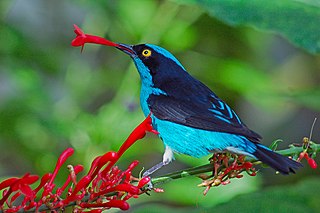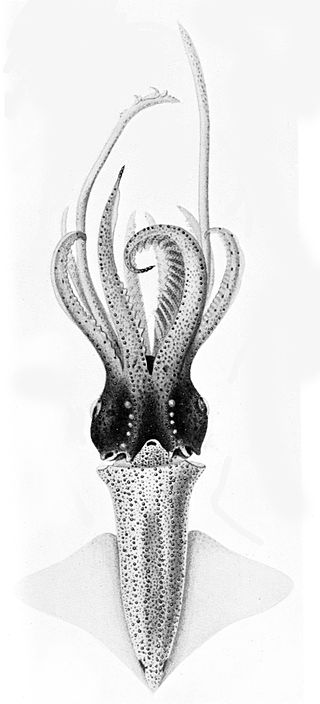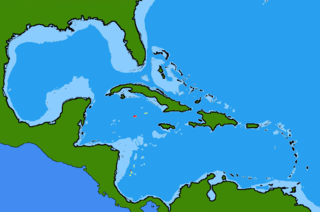
Enoploteuthidae is a family of squid comprising approximately 40 species in four genera. Most species have a mantle length ranging from 3–13 cm (1.2–5.1 in). Hooks are present on all arms and tentacles. The family is best known for the large array of photophores throughout the body.

The barred cuckooshrike, also called the yellow-eyed cuckooshrike, is a species of bird in the family Campephagidae. It is found in eastern Australia, Indonesia, Papua New Guinea, and Solomon Islands.

The black-faced dacnis is a species of bird in the family Thraupidae. It is commonly found typically in pairs throughout the Amazon Rainforest.

Abraliopsis is a genus of squid in the family Enoploteuthidae, comprising 11 nominal species. Species are characterised by the presence of photophores on arm pair IV. Suckers are absent from this arm. The type species is Abraliopsis hoylei.

Abraliopsis morisii is a species of bioluminescent squid in the family Enoploteuthidae. The species occurs in tropical to warm temperate waters in the Atlantic Ocean, including the Gulf of Mexico and the Mediterranean Sea. It can be found in the epipelagic and mesopelagic zones. Jean Baptiste Vérany described the species in 1839 and it reaches lengths of 25 to 33 millimetres. It is rated as least concern by the International Union for Conservation of Nature (IUCN).

Starksia y-lineata, the forked bar blenny, is a species of labrisomid blenny native to reef environments of the Caribbean Sea. This species can reach a length of 1.9 cm (0.75 in) SL.
The red-billed pytilia is a species of estrildid finch found in Ethiopia. It was split from the red-winged pytilia.

Brookesia lineata, also commonly known as the lined leaf chameleon, is a species of chameleon that is endemic to Madagascar. It was first described by Raxworthy and Nussbaum in 1995. The International Union for Conservation of Nature ranked this as an endangered species.
Abraliopsis affinis is a species of enoploteuthid cephalopod in the tropical waters of the eastern Pacific Ocean, and is known from Chile, Colombia, Costa Rica, Ecuador, El Salvador, Guatemala, Honduras, Mexico, Nicaragua, Panama and Peru. It was described by Pfeffer in 1912 and is rated as a least-concern species by the IUCN.
Abraliopsis atlantica is a species of enoploteuthid cephalopod found in the tropical and subtropical Atlantic Ocean, including the Caribbean Sea, the Gulf of Mexico and the Benguela Current. Female oocytes are around 1 mm in length and number between 4,000 and 29,000 in mature females. There is a lack of information about the species and it is rated as data deficient by the International Union for Conservation of Nature (IUCN) due to this. It was described by Kir Nesis in 1982.
Abraliopsis chuni is a species of enoploteuthid cephalopod known from Indo-Pacific waters. Very little is known of this species.
Abraliopsis falco is a species of enoploteuthid cephalopod found in the tropical waters of the East Pacific Ocean, and is known from Chile, Colombia, Costa Rica, Ecuador, El Salvador, Guatemala, México, Nicaragua, Panamá, Perú and the United States. Females are larger than males, reaching sizes of 41–46 mm mantle length, with males reaching 35–37 mm mantle length.

Abraliopsis felis is a species of enoploteuthid cephalopod found in cool temperate water of the north Pacific Ocean. Female oocytes measure 1.5 mm in length.
Abraliopsis gilchristi is a species of enoploteuthid cephalopods found in southern temperate waters of the south Pacific Ocean, from New Zealand to South Africa, where it is abundant. It undergoes a vertical daily migration, spending the day at depth and moving closer to the surface at night to feed on copepods, euphausiids and hyperiids. Spawning appears to occur between September and December. The specific name honours the Scottish zoologist John Gilchrist (1866-1926) who was the first director of the Marine Biological Survey in Cape Town. The type specimen was taken off Cape Town and is held in the Natural History Museum, London.

Abraliopsis hoylei is a species of enoploteuthid cephalopod whose type locality is the Mascarene Islands, but this is uncertain, and the type specimen has been damaged, making taxonomic determination difficult.
Abraliopsis pacificus is a species of enoploteuthid cephalopod from the northwestern Pacific Ocean, from Japan to Hawaii. This species undergoes vertical migration from 900–500 m depth during the day, rising to 263–102 m depth at night. Male spermatophores are 6.5–7 mm in length.
Abraliopsis tui is a species of enoploteuthid cephalopod found in the waters around New Zealand and the Kermadec Islands.
Quercus lineata is a species of Quercus (oak) in the beech family Fagaceae, belonging to subgenus Cerris, section Cyclobalanopsis. It was first described by Carl Ludwig von Blume.

Abraliopsis pfefferi, also known as Pfeffer's enope squid, is a species of squid from the genus Abraliopsis. The species has been observed in the North Atlantic Ocean.










